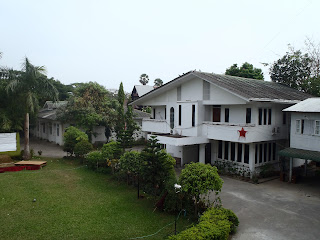For the past several weeks, Claudine and myself have been going to see a doctor on a weekly basis. This is not because we have become paranoid hypochondriacs, but because the doctor in question practices Chinese medicine and acupuncture. Claudine heard about this doctor from a friend of ours who has been going to his surgery for the past 25 years. A bad shoulder was the reason that prompted Claudine to begin seeing him, and a neck injury plus stomach complaint in my case.
To reach his surgery, one must take the Silom line of Bangkok's sky train to its terminus on the opposite side of the Chao Phraya river. From here, it's a 20 min taxi ride out into the suburbs of Bangkok. On alighting from the taxi, one must step out into a bustling road (a good life insurance helps or a Thai to step out in front of you) and cross to a rather nondescript shop front. I use the word bustling, because it's not just a busy road, but a road full of stalls selling everything from hand-woven table mats, to every kind of vegetable, fish, and meat - all covered in flies to add a finishing touch to the presentation of the various wares. Imagine heath and safety in amongst that lot! Peppered around are shops selling Buddhist paraphernalia. There are several wats (temples) near by.
On sliding the grimy door open, one's eyes are met with what at first appears to be a shop filled with an assortment of different artifacts - a TV, statues, various bottles staring out from high cabinets. Around the walls and on top of shelves, one can see a mixture of images ranging from diagrams of the anatomy, portraits of monks, and the Thai royal family - not literally, but in images. A few photographs of the doctor in his youth also grace the wall. A tall clock sounds out the Westminster chimes. Overall, the feeling is of a junk shop filled with redundant collectables rather than a surgery.
From behind an ageing screen, a small, shuffling 77 year old gentleman appears.
We're greeted with the traditional Thai greeting "Sawadee krap" along with the wai (hands placed together as if in prayer). He summons us to sit down and proceeds to address us in his best English.
He's been practicing in these premises for the past 45 years and lives above the surgery. He came to Thailand after his father decided to emigrate here, only leaving for the necessary years to pursue medical studies in Bejing and Hong Kong.
He begins with some standard examinations before proceeding to acupuncture - feeling both wrists to gauge the heart rate, inspection of the tongue with a small torch. In Chinese medicine, the tongue plays an important role in suggesting a diagnosis of a maladie. Practitioners believe that each area of the tongue represents a different part of the body e.g. tip of the tongue: heart, center of the tongue: spleen and stomach etc.
On completion of these examinations, you’re invited to follow him behind the screen, the area behind being not much bigger that a small bathroom. This is the area in which he has his treatment table. A small Chinese spirit temple adorned with lights and burning incense (to keep the spirits happy and procure their protection of the premises) sits on the floor in the corner.
Next, it’s to the treatment table for the fun part – the placing of the needles.
For anyone who doesn’t know (or who’s afraid to ask), the general theory of acupuncture is based on the premise that bodily functions are regulated by the flow of energy. Acupuncture aims to correct imbalances in the flow by stimulation of anatomical locations on or under the skin called acupuncture points. These points are connected by channels known as meridians.
I used to be skeptical about such treatments. This was until the moment that I developed excruciating back pain in Geneva. I went for one treatment for the back and have never had a problem since! The treatment here is working for both Claudine and myself, so there must be something in this treatment.
He usually places about eight acupuncture needles into me. I lay staring at the surgery's water stained ceiling - I must resemble a large pincushion. You hardly feel a thing! After about 10 minutes (during which he’s in the back rooms preparing the special medicine.) he returns and removes the needles. The treatment on the energy flow continues its work for the rest of the day.
He gives us our medication – three bottles of liquid - the contents like a cross between tar and liquorice. As the accompaniment to this, sixteen small tablets (resembling mouse droppings) are to be taken twice daily.
Last Saturday’s treatment finished with a treatment of another kind – a tuk-tuk ride in the fresh air………………

























